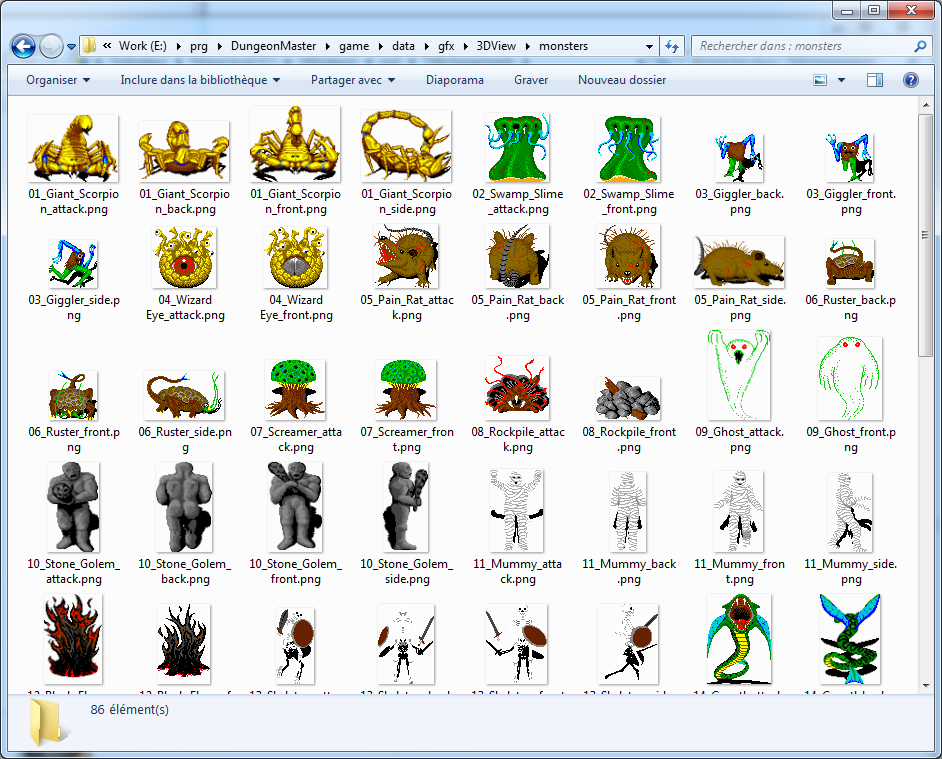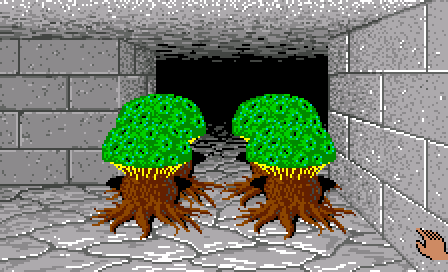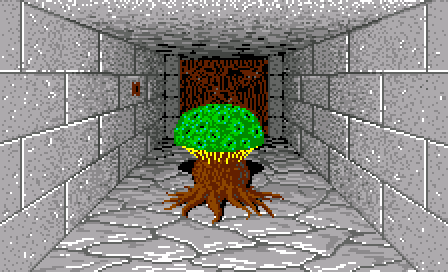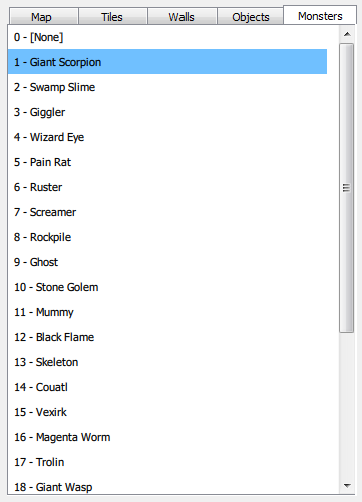Downloads
Executable for the map editor - temporary version (Windows 32bits)
Executable for the game - exactly the same as in part 38 (Windows 32bits)
Before you try to compile the code go to the "Projects" tab on the left menu, select the "Run" settings for your kit,
and set the "Working directory" to the path of "editor\data" for the editor or "game\data" for the game.
Monster graphics

Each monster can have an image for each direction - front, side, back - and an attack image.
The only exception is the Materializer who has a 3 frames animation.
But some monsters will not have all these frames. I.e. the screamer has 2 images because it is symetrical.
We will see the use of these images later. At the moment they will allow us to create a monsters' database.
<?xml version="1.0" encoding="utf-8"?>
<monsters>
<!-- 00 None -->
<monster name = MONSTER00">
</monster>
<!-- 01 Giant Scorpion -->
<monster name = MONSTER01">
<img_front>01_Giant_Scorpion_front.png</img_front>
<img_side>01_Giant_Scorpion_side.png</img_side>
<img_back>01_Giant_Scorpion_back.png</img_back>
<img_attack>01_Giant_Scorpion_attack.png</img_attack>
</monster>
<!-- 02 Swamp Slime -->
<monster name = MONSTER02">
<img_front>02_Swamp_Slime_front.png</img_front>
<img_attack>02_Swamp_Slime_attack.png</img_attack>
</monster>
[...]
</monsters>

When there is only one monster it could be on one of these 4 positions, but after a while it will get to the center
of the tile:

Later in the game we will see bigger monsters that are 2 or 4 times the size of these ones. The maximum number of
monsters on the tile will then be reduced accordingly.
But we will talk about that later, for now we will begin to include these groups in the editor.
The monsters tab

This tab is added in "MainForm.ui.qml".
Tab {
id:monstersTab
title: qsTr("Monsters")
source:"/MonstersTab.qml"
clip: true
}
import QtQuick 2.5
import QtQuick.Controls 1.4
import QtQuick.Layouts 1.2
ScrollView
{
ListView
{
model:monstersList
currentIndex: bridge.monsterType
highlightMoveDuration: 0
delegate: Item {
width: parent.width - 12
height: 25
Text {
x: 6
width: parent.width - 12
anchors.verticalCenter: parent.verticalCenter
text: modelData
}
MouseArea {
anchors.fill: parent
onClicked: bridge.monsterType = index
}
}
highlight: Rectangle { color: "#70c0ff" }
}
}
ScrollView {
id: monsterSelScroll
visible: bridge.monsterSelScrollVis
anchors.fill: parent
GridLayout {
id: mSelGrid
objectName: "oSelGrid"
rowSpacing: 4
columnSpacing: 4
rows: 3
columns: 2
anchors.fill: parent
Label {
id: mPosLabel
height: 20
text: qsTr("Position:")
verticalAlignment: Text.AlignVCenter
renderType: Text.QtRendering
}
Label {
id: mPosValue
height: 20
text: bridge.selPosition
verticalAlignment: Text.AlignVCenter
}
Label {
id: mTypeLabel
height: 20
text: qsTr("Type:")
verticalAlignment: Text.AlignVCenter
horizontalAlignment: Text.AlignLeft
}
ComboBox {
id: mTypeValue
model: monstersList
currentIndex: bridge.selMonsterType
}
}
}
Storing the monsters
class CMonsterGroup
{
public:
CMonsterGroup();
CMonsterGroup(const CMonsterGroup& rhs);
virtual ~CMonsterGroup();
void setType(uint8_t type);
uint8_t getType();
CMonsterGroup& operator=(const CMonsterGroup& rhs);
void load(FILE* handle);
void save(FILE* handle);
CParam* findParamByName(QString name);
CVec2 mPos;
std::vector<CParam*> mParams;
private:
void deleteParams();
uint8_t mType;
};
//---------------------------------------------------------------------------------------------
class CMap
{
[...]
CMonsterGroup* addMonsterGroup(CVec2 pos);
CMonsterGroup* findMonsterGroup(CVec2 pos);
void removeMonsterGroup(CVec2 pos);
[...]
std::vector<CMonsterGroup> mMonsterGroups;
[...]
The tools
class drawMonsterTool : public QUndoCommand
{
public:
explicit drawMonsterTool(QUndoCommand *parent = 0);
bool init(CVec2 pos, int type);
void undo() override;
void redo() override;
private:
CVec2 mPos;
int mType;
CMonsterGroup mOldMonster;
};
drawMonsterTool::drawMonsterTool(QUndoCommand *parent)
: QUndoCommand(parent)
{
}
bool drawMonsterTool::init(CVec2 pos, int type)
{
mPos = pos / TILE_SIZE;
if (mPos.x < 0 || mPos.x >= map.mSize.x ||
mPos.y < 0 || mPos.y >= map.mSize.y)
return false;
CMonsterGroup* group = map.findMonsterGroup(mPos);
if (group != NULL)
mOldMonster = *group;
else
mOldMonster.setType(0);
if (mOldMonster.getType() == type)
return false;
mType = type;
return true;
}
void drawMonsterTool::undo()
{
if (mOldMonster.getType() == 0)
{
map.removeMonsterGroup(mPos);
}
else
{
CMonsterGroup* group = map.addMonsterGroup(mPos);
*group = mOldMonster;
}
bridge.updateQMLImage();
}
void drawMonsterTool::redo()
{
CMonsterGroup* group = map.addMonsterGroup(mPos);
group->setType(mType);
bridge.updateQMLImage();
}
As well as the selection rectangles drawing.
As I said earlier, the monsters groups in this version of the editor only holds a type.
We will need to add some parameters to them, like the number of monsters in the group.
So this version of the editor is only temporary, and I did not convert the maps to the new format.
We will continue that in the next part.